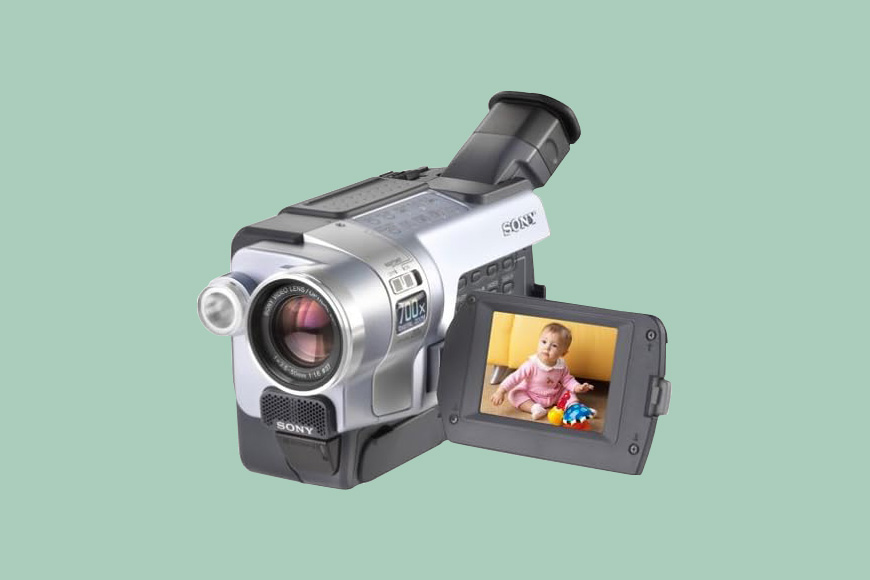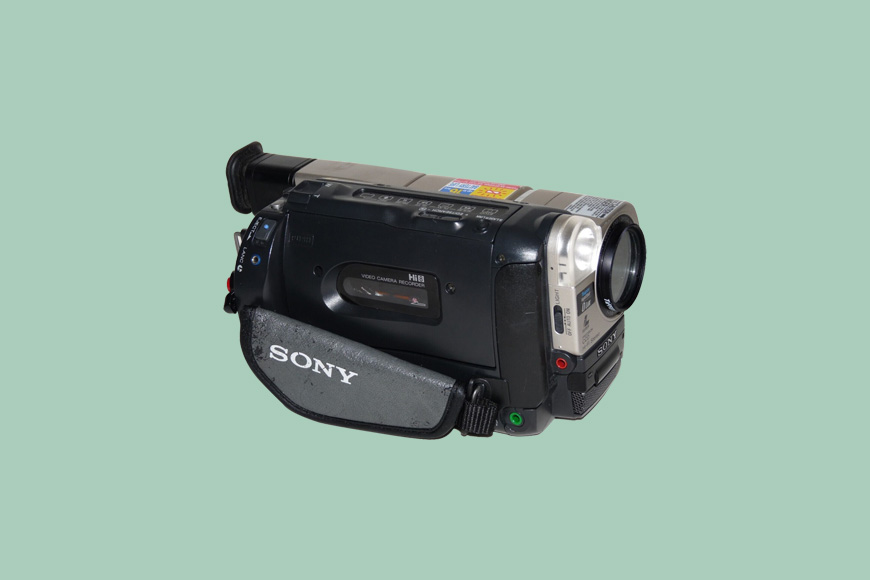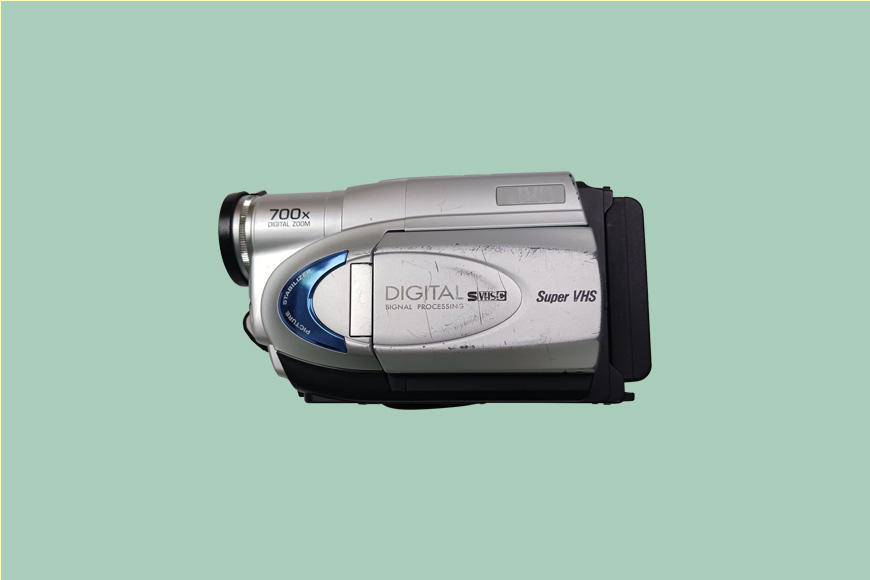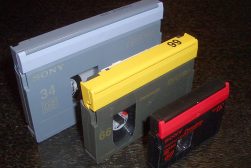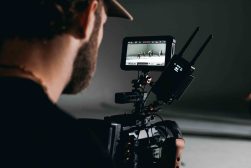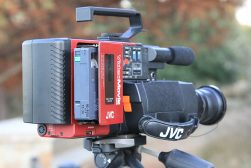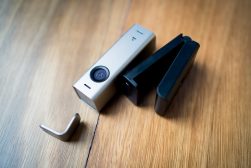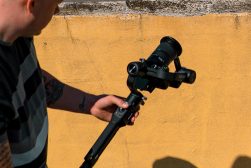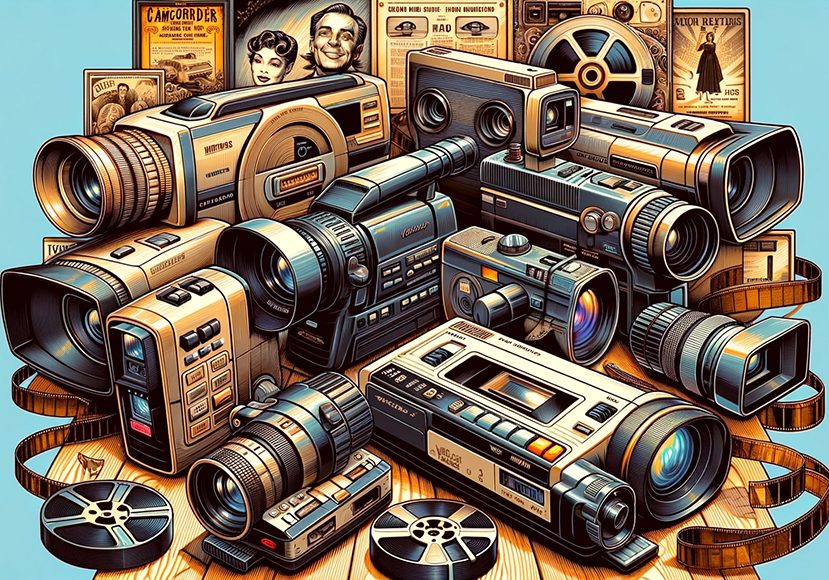
What Vintage Camcorder Should You Buy in 2024?
Find out which vintage camcorder is the best buy this year, balancing classic aesthetics with functionality for your nostalgic filming needs.
This guide will help you decide which vintage camcorder you should buy this year.
There’s nothing like that retro feel, both for a bit of nostalgia and to test you creatively – but it can be difficult to decide what to buy. Especially when equipment needs to be bought second-hand.
Fear not! This article will guide you. I’m going to let you know what to look out for and how to make that choice, as well as suggest some models you might want to consider.
So, let’s get stuck in.
What Are Vintage Camcorders?
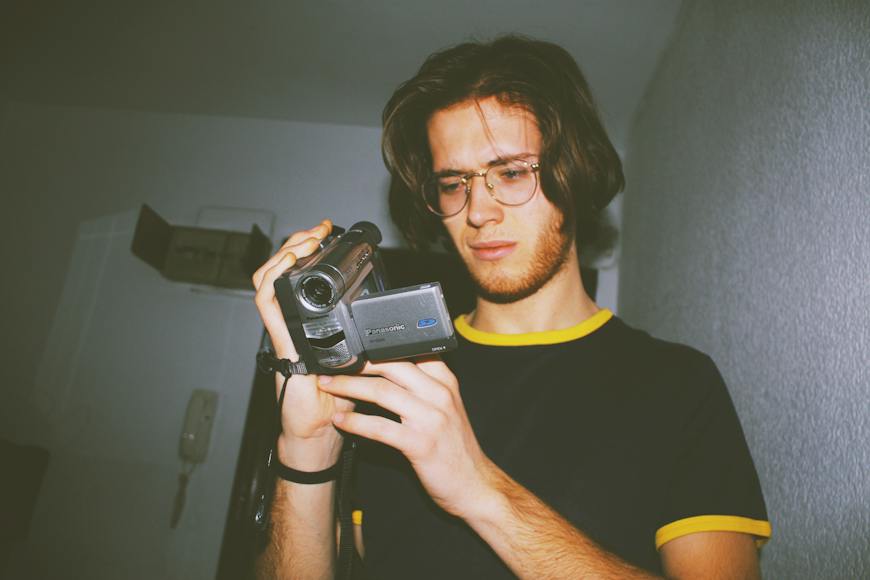
Credit: Rafael Pires
They are portable, handheld video recording devices that were popular during the late 20th century, typically from the 1980s to the early 2000s.
They integrated both a camera and a VCR (video cassette recorder) into a single unit, allowing users to conveniently record and play back videos.
They were typically battery-powered and used analog recording formats such as VHS, VHS-C, Hi8, or Digital8 tapes.
What Is the Difference Between a Camcorder and a Video Camera?
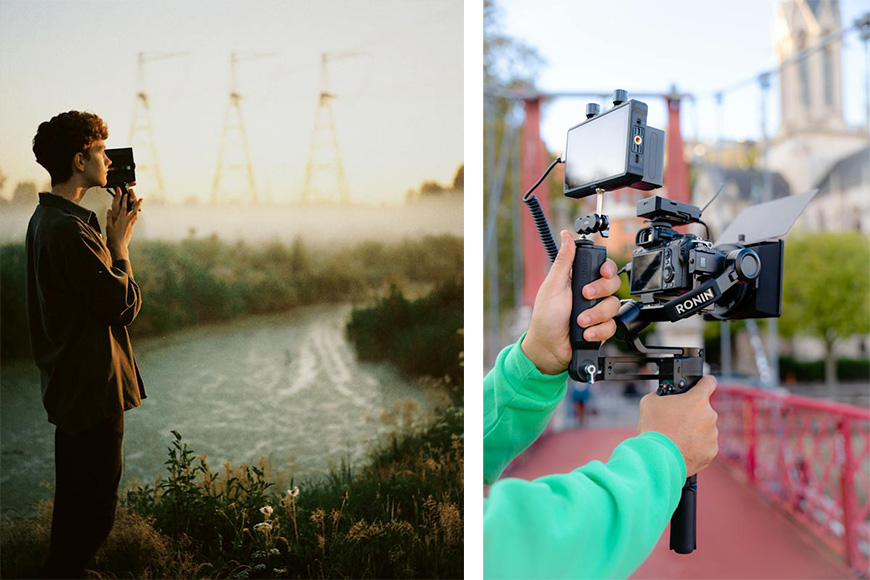
Credit: Phgaltri (left) / Assedrani Official (right)
The terms are often used interchangeably, but they do have subtle distinctions.
A camcorder is a compact, all-in-one device designed for both capturing video and recording audio.
Its integrated design combines the camera lens, imaging sensor, and audio recording components in a single unit.
Camcorders also usually have built-in microphones to capture audio while recording footage.
They’re user-friendly with a small form factor, making them extremely portable.
Early, or vintage, camcorders also tend to record in analog formats, whereas modern ones use SD cards or built-in memory.
“Video camera” is a more generic term and refers to anything designed specifically for capturing moving images, for hobbyists up to cinema professionals.
They come in many shapes and sizes and often have a modular design, allowing customization of components such as lenses, microphones, and external recorders.
High-end video cameras often have larger sensors, interchangeable lenses, and manual controls to give users more creative flexibility.
These kinds of video cameras can often record onto a range of different media and to varied formats, and they often need external audio (and sometimes lighting) setups.
Are Vintage Video Cameras Worth Anything?
Yes, vintage video cameras can be very valuable for collectors, enthusiasts, and filmmakers seeking a retro aesthetic.
The worth of a vintage video camera depends on how rare it is, the brand, the condition it’s in, how much it’s in demand, and whether it works or not.
Why Shoot With a Vintage Camcorder?
Shooting with a vintage video camera offers a unique and nostalgic experience.
With the warm tones, subtle imperfections, and overall retro aesthetic their analog recording formats produce, they stand out from the crisp, digital images of modern cameras.
The sense of nostalgia they evoke can also bring back memories of home videos and family gatherings, creating a sentimental connection to the past.
From a technical standpoint, the limitations of this kind of video recorder, such as its lower resolution and limited manual controls, can enhance creativity.
Embracing the camcorder’s limitations can lead to more thoughtful composition and a focus on storytelling.
It’s also a more hands-on, tactile experience. Having to load tapes and adjust settings manually can make it feel like you are actually doing more and are more invested in the outcome.
Some of these camcorders also come with unique features like built-in effects, night vision capabilities, or distinct lens characteristics. Using these can add a distinctive vintage touch to your footage.
Lastly, whenever you get involved with anything vintage, you’ll find you’re instantly part of a community of fellow enthusiasts.
Diving into the vintage video camera community to share experiences, tips, and creative projects can be extremely rewarding.
How to Choose the Best Vintage Camcorder
Choosing the best vintage video camera or camcorder requires you to think carefully about your needs, budget, and desired nostalgic aesthetic.
First and foremost, you want to get a camcorder that’s in good working condition.
If you are shopping in a physical shop, check for signs of wear, corrosion, or damage, and ask about the maintenance history and whether it has undergone any repairs.
If you’re shopping online, you can still ask the same questions and check photos, but also make sure the seller has a return policy.
Make sure you know the type of format the video camera uses, such as VHS tapes, VHS-C, Hi8, or Digital8. That will determine what the footage will look like, and also compatibility with both playback and conversion equipment.
Check the lens to make sure it’s well-maintained and has no scratches or fungus. A good lens equals good-quality images.
Also, consider the zoom capabilities of the camcorder. Vintage models may have varying optical and digital zoom ranges, which you may or may not need.
Choose a camcorder with better low-light capabilities if you know you’ll be shooting in diverse conditions, and also consider its audio capabilities carefully if you know you’ll be recording with sound.
Vintage video cameras may have mono audio recording, so might not have the best quality audio. If necessary, look for models with external microphone support.
Other things to consider are the type of battery the camcorder comes with (can you easily get replacements?), and whether other spare parts for that model are readily accessible.
That probably seems like quite a long list of things to consider when choosing an old camcorder, but, as with all purchases of equipment that’s no longer manufactured, it’s better to be safe than sorry.
Are There Any Vintage Camcorders That Use an SD Card?
SD cards are a relatively modern invention, and vintage video cameras, not being modern, were designed to use analog formats like Digital8, Hi8, VHS-C, or VHS tapes.
However, some manufacturers might have produced hybrid models toward the end of the analog era, during the transition to digital recording.
Vintage camera dealers, online marketplaces, or forums for enthusiasts will have the most accurate information about this topic.
What About Vintage Camcorders with Night Vision?
Yes, some did come with night vision.
Panasonic had a Night View series, and Sony had NightShot technology which was featured in some of its Handycam camcorders, for example, the Sony Handycam CCD-TRV87.
JVC, too, offered camcorders with low-light capabilities using their NightAlive tech. One such device was the JVC GR-SXM260U.
Can I Shoot with a Camcorder Made in the 80s?
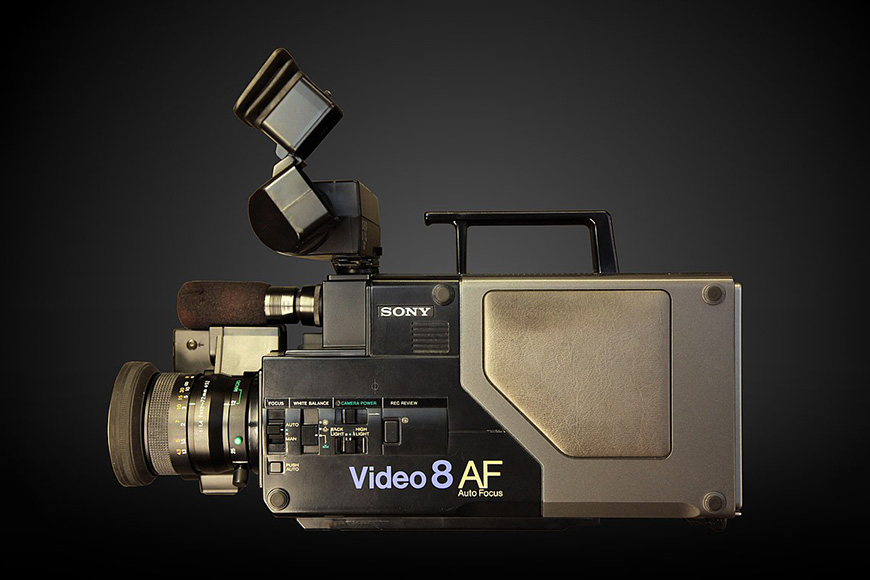
CCD-V8AF-E video 8 camcorder, Sony corporation, 1985. Credit: Rama, CC BY-SA 3.0 FR, via Wikimedia Commons
In the realm of the vintage video camera, the transition from the 1980s to the 1990s saw a notable evolution in both technology and design.
Camcorders from the ’80s were characterized by analog formats like VHS and Hi8, which possess a distinctive warmth and manual control that appeals to enthusiasts looking for a nostalgic feel.
Despite this, it’s often better to shoot with a video camera from the ’90s.
At that time, there was a shift toward digital formats such as Digital8 and MiniDV, which offered higher resolution and improved image quality.
Not only did ’90s camcorders provide greater footage clarity, but they also embraced more compact designs. The ’80s camcorders are notoriously bulky and therefore less portable.
They also became more user-friendly. With the inclusion of features like automatic functions, improved low-light performance, and the advent of LCD screens, ’90s camcorders struck a nice balance between a vintage aesthetic and modern convenience.
Choosing a video camera from the ’90s allows users to enjoy the nostalgic charm of analog recording while benefiting from the technological enhancements that made them a step beyond their ’80s counterparts.
4 Best Vintage Camcorders You Can Still Buy Today
For anyone looking to get an authentic vintage feel to their footage by using a genuine vintage video camera, there are quite a few options out there.
Of course, they’re generally on the second-hand market but can often be found refurbished, with warranties, and at a decent price.
Here are a few we think are particularly good:
Sony Digital8 Camcorder DCR-TRV350
- Reverse compatible
- Great optical and digital zoom
- Reliable and versatile
- SteadyShot image stabilization
- LCD screen is small
- Quite expensive
The Sony Digital8 Camcorder DCR-TRV350 is a versatile video camera, particularly useful for anyone who already has a collection of older tapes.
This device has reverse compatibility, which means it can play both Digital8 and Hi8 tapes. This feature also means that users can transfer their analog recordings into digital format.
It has a 2.5-inch LCD screen, which, although small by today’s standards, was very good for the time. Regardless, it’s plenty to see by, both for playback and filming.
And it boasts a 20X optical zoom (and a 700X digital zoom), so you can shoot things that are pretty far away.
As the Sony Digital8 also has SteadyShot, you should also be able to get stable, non-shaky footage of even those distant scenes or subjects.
It has a NightShot creative mode, too, to help you shoot in low-light conditions.
The camcorder can easily be connected to a TV for playback, or to a computer to transfer the files across for playback or storage.
Panasonic PV-L550 VHS-C Camcorder
- Lightweight and compact
- User-friendly
- Image stabilisation
- Rotating screen
- Great optical zoom
- Small LCD screen
- Smaller digital zoom than others
- Only records VHS-C
This vintage video camera option, the Panasonic PV-L550 VHS-C Camcorder, is well-known for its compact design and use of VHS-C tapes.
Its small size and low weight make it extremely portable, and its simple design means it’s exceptionally user-friendly.
You get a 2.5-inch, 180-degree rotating viewfinder, which is plenty for shooting and playback. Its rotation also helps you get footage from tight angles.
It also has an 18X optical zoom (and a 150X digital zoom), which was good for its time. Combine that with electronic image stabilization, and you get clear footage both near and far.
As it records in VHS-C format, it will be of particular interest to people who are nostalgic for that format or those interested in digitizing their old footage.
Sony Handycam CCD-TRV87
- Very affordable
- Image stabilisation
- Reliable
- User-friendly
- Versatile
- Impressive digital zoom
- Can be difficult to source spare parts
The Sony Handycam CCD-TRV87 is the perfect vintage video camera for those on a budget. You can pick one up for under $100 on eBay.
It records in Hi8, which provides excellent image quality, and that footage is image-stabilized, so you don’t have to worry about shakiness.
It has a 20X optical zoom (a massive 990X digital zoom), plus a Super NightShot infrared system, which helps you ensure good footage in challenging lighting conditions.
Like the previous two camcorders, it has a 2.5-inch color LCD screen to help with both image composition and playback.
Despite being one of the older camcorder models out there, it’s well-known for being reliable.
JVC GR-SXM260U
- Durable
- Cheap video camera
- User-friendly
- Image stabilisation
- Great optical and digital zoom
- Only shoots VHS-C
Another budget camcorder option (you can pick one up for around $40 on eBay), and a video camera that, in its day, was extremely popular.
The JVC GR-SXM260U is a compact and feature-rich device with a 20X optical zoom (and 700X digital zoom) and digital image stabilization, which ensures users can capture steady, clear footage even if the subject is far away.
As with the others, this camcorder has a 2.5-inch color LCD screen to aid with shooting and playback.
It has a built-in video light to help with low-light conditions, plus the option to shoot in Auto or Manual focusing modes for extra control and creativity.
It records in Super VHS-C format, which offers enhanced video quality – higher than what is produced by standard VHS-C tapes.
How to Get a Vintage Camcorder Effect on a Modern-Day Camera
Achieving that old-style camcorder effect on a modern-day video camera involves attention to detail and a combination of shooting techniques and post-processing.
First, you need to set your aspect ratio to 4:3. This mimics the standard aspect ratio used by older camcorders, giving your footage a vintage feel.
When recording, you can also choose a lower frame rate, such as 24 or 30 fps, to replicate the cinematic and slightly less fluid motion characteristic of older camcorders.
Use manual focus to create intentional softness or slight blurriness in your shots. Older camcorders often had limitations in focus accuracy, contributing to a distinctive look.
Even though some vintage video cameras had image stabilization, it was nowhere near as good as the modern-day iteration.
You can emulate the handheld style of older camcorders by turning this feature off or by introducing subtle shakes and movements to your footage for a more authentic vintage feel.
Vintage footage often had a warmer tone, so using natural light will enhance the nostalgic look.
When it comes to post-processing, you can adjust the color grading to replicate the characteristics of older video tapes. Adjust the white balance to increase the warmth and introduce a slight color cast, such as a subtle sepia or greenish tint.
You can also apply a vignette effect to draw attention to the center of the frame. Older camcorder devices often had a natural vignette due to lens limitations.
Consider using film grain to simulate the texture of older video recordings. Many post-processing software and apps offer customizable grain effects.
Slightly reduce the resolution and sharpness of your footage to mimic the lower quality of older camcorders. This can be achieved either through post-processing or by adjusting camera settings.
If you want to go even further, you could even overlay subtle scan lines on your footage to replicate the look of older analog displays.
Recreating a vintage look is not limited to the images either. If your video includes audio, you can add subtle audio imperfections like static or hum to replicate the sound quality of vintage recordings.
Another touch you could add is to use a timestamp or a vintage-style title overlay to really bring home that vintage look.
Also check out this guide to vintage photography for creating the look with stills.
FAQ
What are old camcorders called?
They’re generally referred to as “vintage.” It’s more respectful!
Is there a market for old video cameras?
As for all things vintage, there is a healthy market.
You can find old video cameras on eBay, on Amazon, and at other outlets.
Of course, you need to do your due diligence and make sure what you’re buying is in good condition.
But, many of these machines can be found fully refurbished and even with warranties.
Camcorders are used to record footage.
Given their ease of use and compactness, they’re often used to film family moments or holidays. But, they have even been used to film movies.
How do you use a vintage camcorder?
Generally, they’re handheld and fit in your palm, held there by a strap.
They are normally very easy to use, with simple features and menus (if they even have menus), an eyepiece viewfinder, and a screen.





